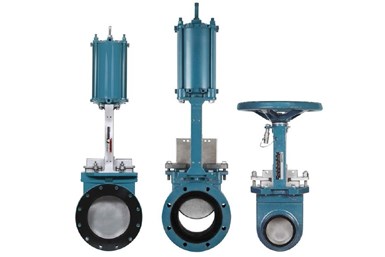DeZURIK Offers Urethane-Lined Valves for Abrasive Materials On-Off Applications
Urethane lined knife gate valves for applications in mining, power, chemical and food industries
#VMAnews #gate-globe-check
DeZURIK’s KUL urethane lined knife gate valves are designed for on-off applications of abrasive slurry and dry abrasive materials. Flanged urethane lined knife gate valves are well-suited for applications in mining, power, chemical and food industries. KUL valves feature a one-piece, cast-in-place bonded liner that provides bi-directional, drip-tight shutoff to either 150 or 250 psi (1030 or 1720 kPa) CWP.

The KUL valve from DeZURIK is offered in three body configurations (from left to right): extended flange, standard flanged and grooved end.
Photo Credit: DeZURIK
These valves can also provide bi-directional dead-end service to the full pressure rating of the valve. All wetted surfaces are lined with urethane. The urethane liner is bonded in place to form a continuous liner throughout the entire body, chest, packing chamber and flange face area. The bonding process enhances the mechanical and abrasion resistance properties of the urethane, which creates a robust seat seal in harsh slurry services.
RELATED CONTENT
-
The Limits of Standard Manual Globe Valves for Throttling
A common practice in process services is to use manual globe valves with hand wheels for regulating flow.
-
Testing of Hydrogen Valves
Valves are used to control all types of fluids, and while some are easy to manage, others can be a challenge. At the top of the challenging list sits hydrogen, the smallest, lightest molecule known to man.
-
The Role of Valves in HAZOP Studies
Process hazard analysis (PHA) is required by U.S.










 Unloading large gate valve.jpg;maxWidth=214)